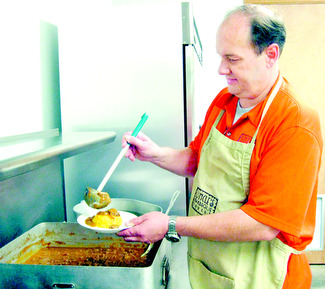All about grillades
Published 2:00 pm Thursday, May 12, 2011

- Chef Hallman Woods III serves up a plate of grillades over grits. The signature dish was served at a Solomon House fundraiser.
Grillades are making a comeback on the breakfast, lunch and dinner table.
Whether served over rice or a heaping pile of grits, grillades — pronounced gree-yahds — is a dish that has a place on any table, casual or elegant, and can even be found on a grand buffet in one of New Orleans’ finest restaurants.
Trending
Cajun and Creole cooks often have a different take on grillades. As with many of the older recipes in South Louisiana, cooks have tweaked the recipes as they were passed down from generation to generation, each creating their own version.
What started as a method of cooking tough cuts of meat with gravy to get it tender and moist, still leaves a few questions up for debate when cooks prepare authentic grillades. Should grillades be cooked with pork or beef meat? Should it be served over grits or rice? By adding tomatoes or tomato paste, does it become more of a Creole dish than a Cajun one?
Chef Hallman Woods III, executive chef for Uncle’s Barbeque Sauce and previous chef at the former Le Rosier Restaurant, often turns to grillades and grits when catering a party or special event.
Topping the menu at the recent Solomon House fundraiser was Woods’ grillades and grits.
“It has become one of our signature dishes. It is a favorite that people really enjoy. I prefer to serve the grillades over white or yellow grits,” said Woods.
Woods said the meat, slowly braised in a sauce with onions, bell pepper, garlic and tomato, has a zesty and full flavor.
Trending
Kenneth Morrogh of New Iberia, grew up eating grillades and he isn’t ready to quit now. With a father born and raised in Arnaudville and a mother from a suburb of New Orleans, who later settled down in Cecilia to raise their family, Morrogh said his mother had to adapt her New Orleans-style recipes to ingredients that were available in a small Cajun town.
‘My first culinary epiphany occurred when Mom was browning round steak in olive oil for grillades.‘
“My first culinary epiphany occurred when Mom was browning round steak in olive oil for grillades. I was about 12 years old then. I can remember walking into the kitchen and just being overwhelmed by the aroma. I remembered thinking to myself, ‘I have got to learn to prepare this,’ and Mom did teach me,” he said.
Morrogh said the term grillades was confusing to him then because his Cajun friends ate grillades, but he recalls it as being pickled pork steak dish that had been covered with vinegar and marinated for a day or two, then seasoned, browned and braised, while the classic New Orleans style grillades are prepared with veal round steak that has not been marinated.
My mother’s grandmother, known to us as Gram, would have a fit if it was prepared with anything but veal,” he said.
Since veal wasn’t available in the small Cajun country store in Cecilia, Morrogh said his mother substituted veal with round steak that had been pounded with a tenderizing hammer.
“My family and I have enjoyed this recipe over the years,” he said.
Morrogh says “no thank you” when it comes to grits. He prefers his grillades served the Cajun way — over rice.





